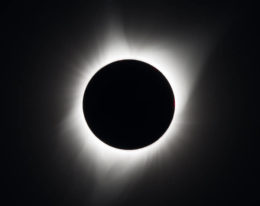What did the Parker Solar Probe observe when it got closer to the Sun than any spacecraft has ever ventured? Astronomers peer into the solar magnetic field to find out.
Probing the Sun’s Surface
Obtaining high-quality observations of the Sun has been important to astronomers for centuries, in large part because the Sun is capable of unleashing space weather events that not only produce the spectacular northern lights, but can also totally knock out our power grids and GPS systems. Therefore, understanding the Sun’s atmosphere and magnetic fields, where these weather events originate, is key.
The Parker Solar Probe, which launched in 2018, completed its closest encounter with the Sun last month, entering its corona (the hot, tenuous upper atmosphere). This marked the closest any spacecraft has ever gotten to the solar surface. The mission’s primary goal is to fly into the corona and sample particles and magnetic fields to get a better understanding of what drives the solar wind. A group of plasma physicists has now used these data to analyze the magnetic fields and plasma waves in the Sun’s atmosphere in unprecedented detail.
Waving Hello to Results at Small and Large Scales

The normal, tangential, and radial components of the magnetic field and velocity of particles observed by the Parker Solar Probe on two different days. Click to enlarge. [Zhao et al. 2021]
The team looked at two scales: magnetohydrodynamic (which treats the plasma as a conducting fluid) and ion-kinetic (which treats the plasma as a collection of individual particles). Using Parker Solar Probe’s observations, the authors analyzed the flow of particles at these scales and found that different types of waves occur at each scale. The presence of waves at both large and small scales supports specific models of magnetic fluctuations and instabilities within the solar system, especially close to the Sun, which could lead to a better understanding of the solar wind. The authors’ work helps to home in on how the solar wind accelerates from a gentle breeze near the solar surface to the 400-kilometer-per-second gale seen near Earth.
The Parker Solar Probe has allowed scientists to get a closer glimpse of the solar surface than ever before. Future measurements with the Parker Solar Probe and the Solar Orbiter, a satellite launched in February 2020 to study the inner heliosphere and solar wind, will give more insight into the solar wind under different conditions (such as different temperatures and speeds) and will allow us to get a better handle on what heats the solar wind.
Bonus
Check out this video from NASA/the Johns Hopkins Applied Physics Laboratory showing the Parker Solar Probe during its closest encounter with the Sun. Streaks in the gif are coronal streamers, which are part of the magnetic field of the Sun and are usually only seen from Earth during solar eclipses. The Milky Way can be seen in the background.
Citation
“MHD and Ion Kinetic Waves in Field-aligned Flows Observed by Parker Solar Probe,” L.-L. Zhao et al 2021 ApJ 922 188. doi:10.3847/1538-4357/ac28fb


